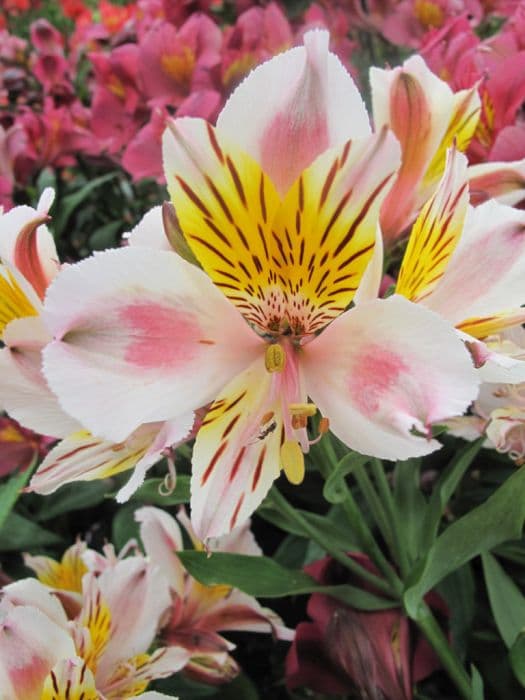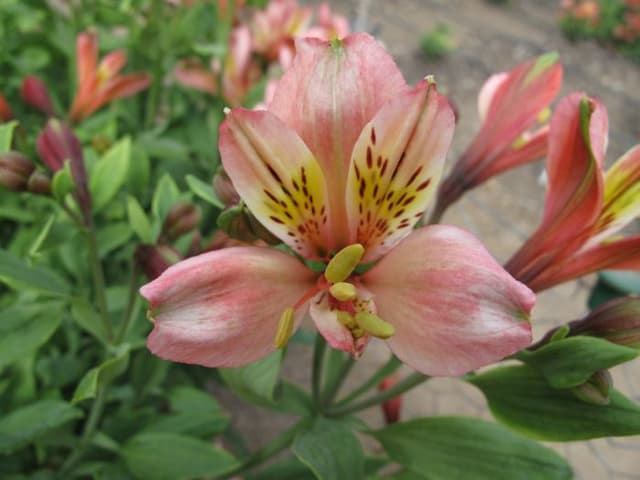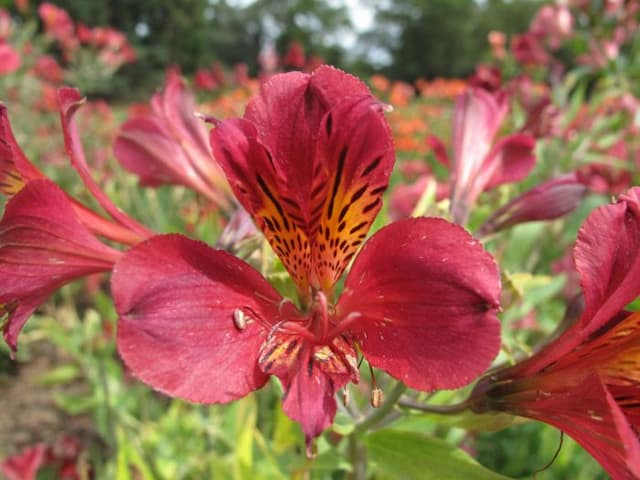Alstroemeria Bomarea edulis

ABOUT
Bomarea edulis, also known as the edible bomarea, is a stunning flowering plant characterized by its vibrant climbing vines. The foliage consists of glossy, green leaves that are lance-shaped and arranged in a spiraling fashion around the stems, giving it a lush appearance. This plant is especially known for its showy, multi-colored flowers, which come in a harmonious mix of reds, oranges, yellows, and pinks. The blooms are tubular with flared tips, arranged in clusters that dangle elegantly from the vine. The overall impression of the edible bomarea is that of a lively and colorful climber, with beautiful inflorescences adding a tropical flair to its surroundings. Its visual appeal is often a highlight in gardens where it can drape over structures or climb up supports, showcasing its ornamental flowers.
About this plant
 Names
NamesFamily
Alstroemeriaceae
Synonyms
Salsilla, Climbing Alstroemeria
Common names
Alstroemeria edulis.
 Toxicity
ToxicityTo humans
Bomarea edulis, commonly known as Alstroemeria, has no reported toxicity to humans. As with many plants, sensitive individuals may experience mild irritation or allergic reactions upon contact or ingestion, but it is not considered poisonous.
To pets
Alstroemeria has mild toxicity to pets. If ingested by pets, particularly cats and dogs, it can cause gastrointestinal upset, including vomiting, diarrhea, and abdominal pain. It contains tulipalin, which can lead to these symptoms. It is important to prevent pets from eating the plant and to consult a vet if they do.
 Characteristics
CharacteristicsLife cycle
Perennials
Foliage type
Evergreen
Color of leaves
Green
Flower color
Red
Height
6-10 feet (1.8-3 meters)
Spread
2-3 feet (0.6-0.9 meters)
Plant type
Climber
Hardiness zones
9
Native area
South America
Benefits
 General Benefits
General Benefits- Ornamental Value: Bomarea edulis, commonly known as Alstroemeria vine, is prized for its showy, colorful flowers that add aesthetic beauty to gardens and landscapes.
- Edible Tubers: The tubers of Alstroemeria vine are edible and can be consumed, similar to potatoes, thus providing a source of food.
- Cultural Significance: In some cultures, the plant is used in traditional ceremonies or celebrations, giving it cultural importance.
- Wildlife Attraction: The vibrant flowers of the Alstroemeria vine can attract pollinators such as bees, butterflies, and hummingbirds, promoting biodiversity.
- Diversity in Landscaping: Alstroemeria vine can be used in various landscaping designs due to its climbing nature, which allows it to cover walls, trellises, and fences.
- Economic Contribution: In regions where it is cultivated, Alstroemeria vine can contribute to the economy through its sale as an ornamental plant.
- Plant Adaptability: Alstroemeria vine can adapt to a range of environments, making it a versatile plant for different climate conditions.
 Medical Properties
Medical Properties- This plant is not used for medical purposes.
 Air-purifying Qualities
Air-purifying QualitiesThis plant is not specifically known for air purifying qualities.
 Other Uses
Other Uses- As an ornamental plant: Bomarea edulis, commonly known as the Salsilla, can be cultivated for its attractive flowers and used to enhance the visual appeal of gardens and landscapes.
- In basket weaving: The flexible vines of the Salsilla can sometimes be harvested and used in the craft of traditional basket weaving.
- Fiber production: In some regions, the plant's fibrous stems may be processed and utilized for making natural fibers.
- Culinary garnish: The bright, showy flowers of the Salsilla could potentially be used as an edible garnish in upscale culinary presentations, although this is not a common practice.
- Education and research: Because of its unique characteristics, Salsilla might be used in botanical studies to educate about plant diversity, climbing mechanisms, or Andean flora.
- Living structure: The climbing nature of Salsilla allows it to be used for creating living fences or green walls as a part of eco-friendly building projects.
- Erosion control: The roots of Salsilla may help stabilize soil in areas prone to erosion, although this use is more speculative.
- Natural dyes: While not traditionally known for this use, the pigments from the flowers or leaves may have potential as natural dyes in textiles or art materials.
- Cultural significance: Salsilla may hold ceremonial or symbolic importance in certain indigenous cultures, being incorporated into rituals or celebrations.
- Seed dispersal study: The seeds of Salsilla, attached to their fluffy appendages, could be of interest in the study of seed dispersal mechanisms in windy environments.
Interesting Facts
 Feng Shui
Feng ShuiThe Bomarea edulis is not used in Feng Shui practice.
 Zodiac Sign Compitability
Zodiac Sign CompitabilityThe Bomarea edulis is not used in astrology practice.
 Plant Symbolism
Plant Symbolism- Resilience - Bomarea edulis, commonly known as Alstroemeria or Peruvian Lily, often symbolizes the ability to persist and adapt due to its hardy nature and ability to thrive in various conditions.
- Friendship and Devotion - The vibrant blossoms and long-lasting nature of the Peruvian Lily flowers are frequently seen as a representation of long-term bonds and steadfastness in relationships.
- Wealth and Prosperity - With its abundance of colorful blooms, the Peruvian Lily is sometimes associated with bringing good fortune and success to one's life.
- Aspiration and Achievement - The upward growth habit of the plant signifies striving for betterment, making it an emblem of reaching for one's goals and dreams.
 Water
WaterSalsilla, a vigorous climber, requires consistent moisture to flourish. During the active growth period in spring and summer, water thoroughly when the top inch of soil feels dry, usually once a week, with one gallon of water per session. During fall and winter, reduce watering to every two weeks, using half a gallon each time, as the plant enters a dormancy period and uses less water. Avoid letting the soil dry out completely, but also avoid waterlogging, which can lead to root rot. Always water at the base of the plant to keep the foliage dry and prevent fungal diseases.
 Light
LightSalsilla thrives best in partial shade or filtered sunlight, making it suitable for east-facing windows or shaded patios where it receives bright, indirect light. Direct sunlight can scorch its leaves, especially in hot climates, so avoid placing it in full sun, especially during the peak hours of the day. A spot that mimics the dappled light of its native forest undergrowth is ideal.
 Temperature
TemperatureSalsilla performs well in temperatures between 50°F and 80°F, making it suitable for most indoor environments. The plant can tolerate short-term temperature drops down to 40°F but should be protected from frost. It is not tolerant of high heat, so during the summer, keep it away from hot windows and ensure good air circulation around the plant.
 Pruning
PruningSalsilla should be pruned to maintain its shape, encourage bushier growth, and remove any dead or damaged stems. The best time for pruning is in the late winter or early spring before new growth begins. Pruning once a year is typically sufficient, but it can tolerate more frequent trimming if necessary to keep its vigorous growth in check. Make clean cuts above the leaf nodes to promote new shoots.
 Cleaning
CleaningAs needed
 Soil
SoilBomarea edulis, also known as Alstroemeria, prefers a well-draining soil mix with good fertility; a blend of peat, perlite, and compost works well. The soil pH should be slightly acidic to neutral, ideally between 6.0 and 7.5.
 Repotting
RepottingAlstroemeria should be repotted every 2 to 3 years or when the pot becomes root-bound. Spring is the best time for repotting to allow for recovery during the growing season.
 Humidity & Misting
Humidity & MistingAlstroemeria thrives best in moderate to high humidity levels, ideally around 50-60%. They benefit from a humid environment but not wet foliage.
 Suitable locations
Suitable locationsIndoor
Place Alstroemeria in bright, indirect light indoors.
Outdoor
Plant Alstroemeria in partial shade outdoors.
Hardiness zone
7-10 USDA
 Life cycle
Life cycleBomarea edulis, also known among other common names as Salsilla or Alstroemeria, begins its life cycle as a seed which, once dispersed and in suitable conditions, germinates and develops a small root system and shoots. This perennial plant then grows into a climbing vine, using its tendrils to attach to supports. It produces lance-shaped leaves and, given enough time and proper care, will eventually blossom with clusters of brightly colored, tubular flowers, typically in reds, oranges, or yellows. Following pollination, which is often facilitated by hummingbirds and insects, the flowers develop into fruit capsules containing seeds. These seeds, once mature, can be dispersed by various means, including animals and gravity. The plant can also propagate vegetatively through its rhizomes, allowing for new individuals to grow in proximity to the parent plant, thus continuing its life cycle.
 Propogation
PropogationPropogation time
Spring-Early Summer
Propogation: The most popular method of propagation for Bomarea edulis, commonly known as the Alstroemeria vine or climbing Alstroemeria, is through division. This process typically happens in the spring, when the plant's growth becomes active, allowing the new divisions to establish more easily. To propagate by division, carefully lift the plant from the ground and separate the tuberous roots into smaller sections, ensuring that each section has at least one or two growth points or eye buds. These sections can then be replanted into pots filled with a well-draining soil mix, ideally composed of equal parts potting soil, sand, and peat, at a depth of about 2 inches (5 cm). After planting, water the divisions thoroughly and maintain a consistent moisture level without over saturating the soil. With warmth and indirect light, the divisions will start to grow and develop into new plants.



![Peruvian lily [Inca Glow]](/_next/image?url=https%3A%2F%2Fplants-admin.emdemapps.com%2Fimages%2Fplants%2F%2Fimages%2F604b5e99e48d9.png&w=640&q=75)
![Peruvian lily [Inca Smile]](/_next/image?url=https%3A%2F%2Fplants-admin.emdemapps.com%2Fimages%2Fplants%2F%2Fimages%2F604b5cad8fa91.png&w=640&q=75)
![Peruvian lily [Inticancha Passion]](/_next/image?url=https%3A%2F%2Fplants-admin.emdemapps.com%2Fimages%2Fplants%2F%2Fimages%2F604b5f7a78c8d.png&w=640&q=75)


![Peruvian lily [Summer Breeze]](/_next/image?url=https%3A%2F%2Fplants-admin.emdemapps.com%2Fimages%2Fplants%2F%2Fimages%2F604b6401573b7.png&w=640&q=75)
